Report on Derivative Instruments for Hertfordshire Petroleum PLC
VerifiedAdded on 2022/08/29
|8
|1475
|17
Report
AI Summary
This report, prepared for Hertfordshire Petroleum plc, provides a comprehensive overview of derivative instruments, focusing on futures, forwards, options, and swaps. It elucidates the principles of futures and forwards pricing, explaining concepts such as cost of carry, contango, and backwardation, and differentiates between futures and forwards. The report also delves into option valuation, discussing the Binomial Tree and Black-Scholes models, along with the determinants of option value. Furthermore, it analyzes the advantages and disadvantages of using options for Hertfordshire Petroleum plc, and briefly covers swaps and embedded options like callable and puttable bonds. The document aims to equip new staff members with a solid understanding of these financial instruments, their valuation, and their practical applications in risk management within the context of a crude oil mining company.
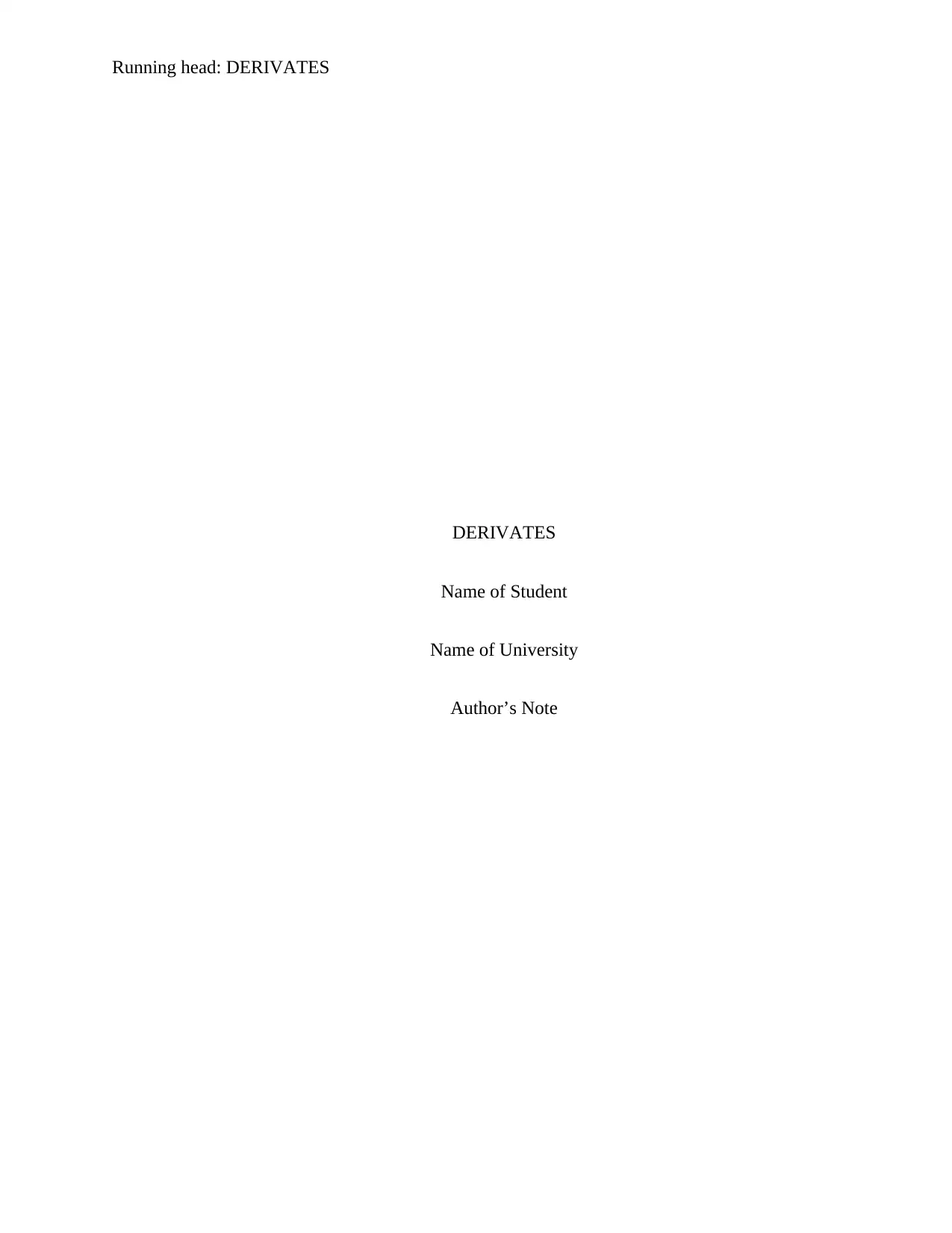
Running head: DERIVATES
DERIVATES
Name of Student
Name of University
Author’s Note
DERIVATES
Name of Student
Name of University
Author’s Note
Paraphrase This Document
Need a fresh take? Get an instant paraphrase of this document with our AI Paraphraser
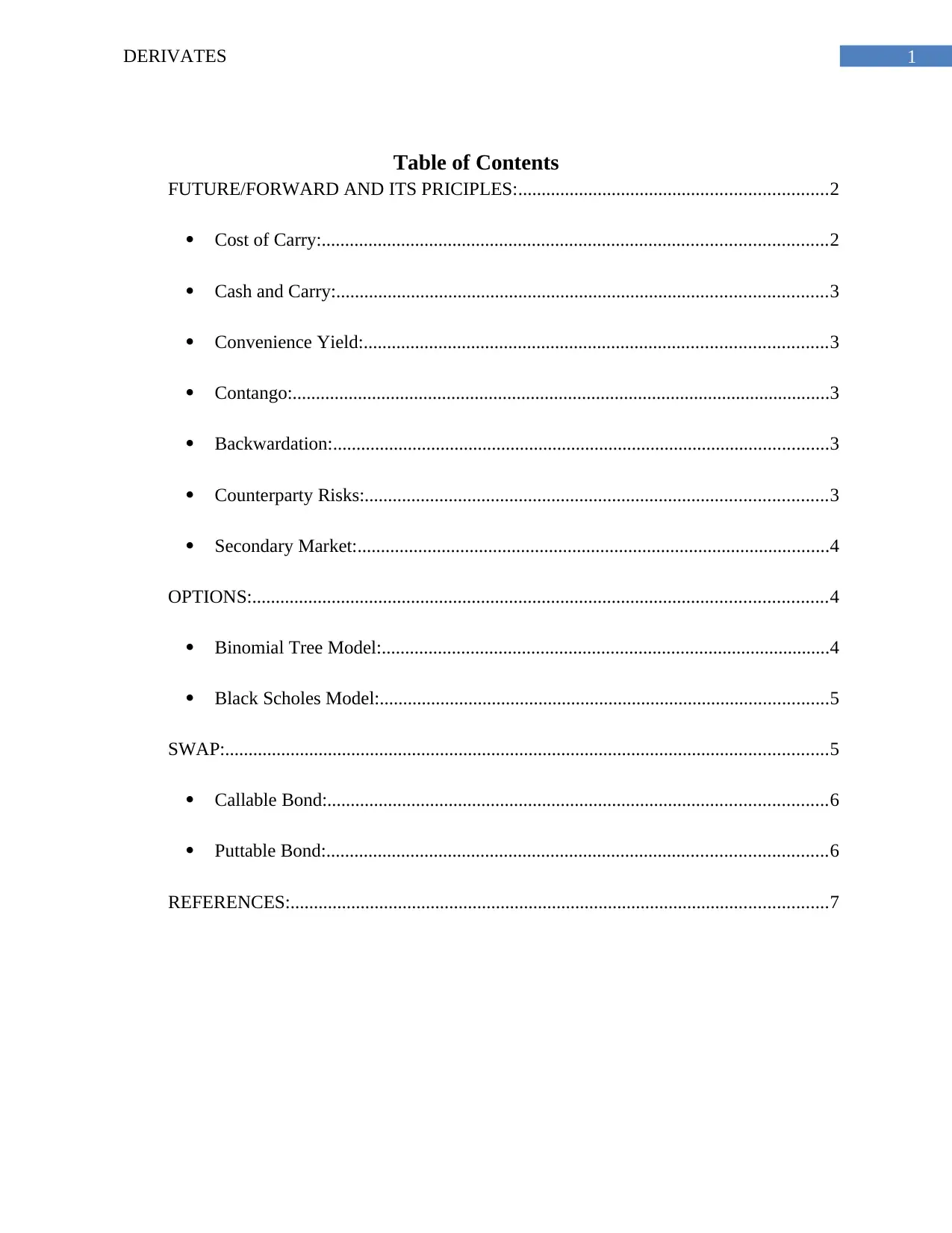
1DERIVATES
Table of Contents
FUTURE/FORWARD AND ITS PRICIPLES:..................................................................2
Cost of Carry:............................................................................................................2
Cash and Carry:.........................................................................................................3
Convenience Yield:...................................................................................................3
Contango:...................................................................................................................3
Backwardation:..........................................................................................................3
Counterparty Risks:...................................................................................................3
Secondary Market:.....................................................................................................4
OPTIONS:...........................................................................................................................4
Binomial Tree Model:................................................................................................4
Black Scholes Model:................................................................................................5
SWAP:.................................................................................................................................5
Callable Bond:...........................................................................................................6
Puttable Bond:...........................................................................................................6
REFERENCES:...................................................................................................................7
Table of Contents
FUTURE/FORWARD AND ITS PRICIPLES:..................................................................2
Cost of Carry:............................................................................................................2
Cash and Carry:.........................................................................................................3
Convenience Yield:...................................................................................................3
Contango:...................................................................................................................3
Backwardation:..........................................................................................................3
Counterparty Risks:...................................................................................................3
Secondary Market:.....................................................................................................4
OPTIONS:...........................................................................................................................4
Binomial Tree Model:................................................................................................4
Black Scholes Model:................................................................................................5
SWAP:.................................................................................................................................5
Callable Bond:...........................................................................................................6
Puttable Bond:...........................................................................................................6
REFERENCES:...................................................................................................................7
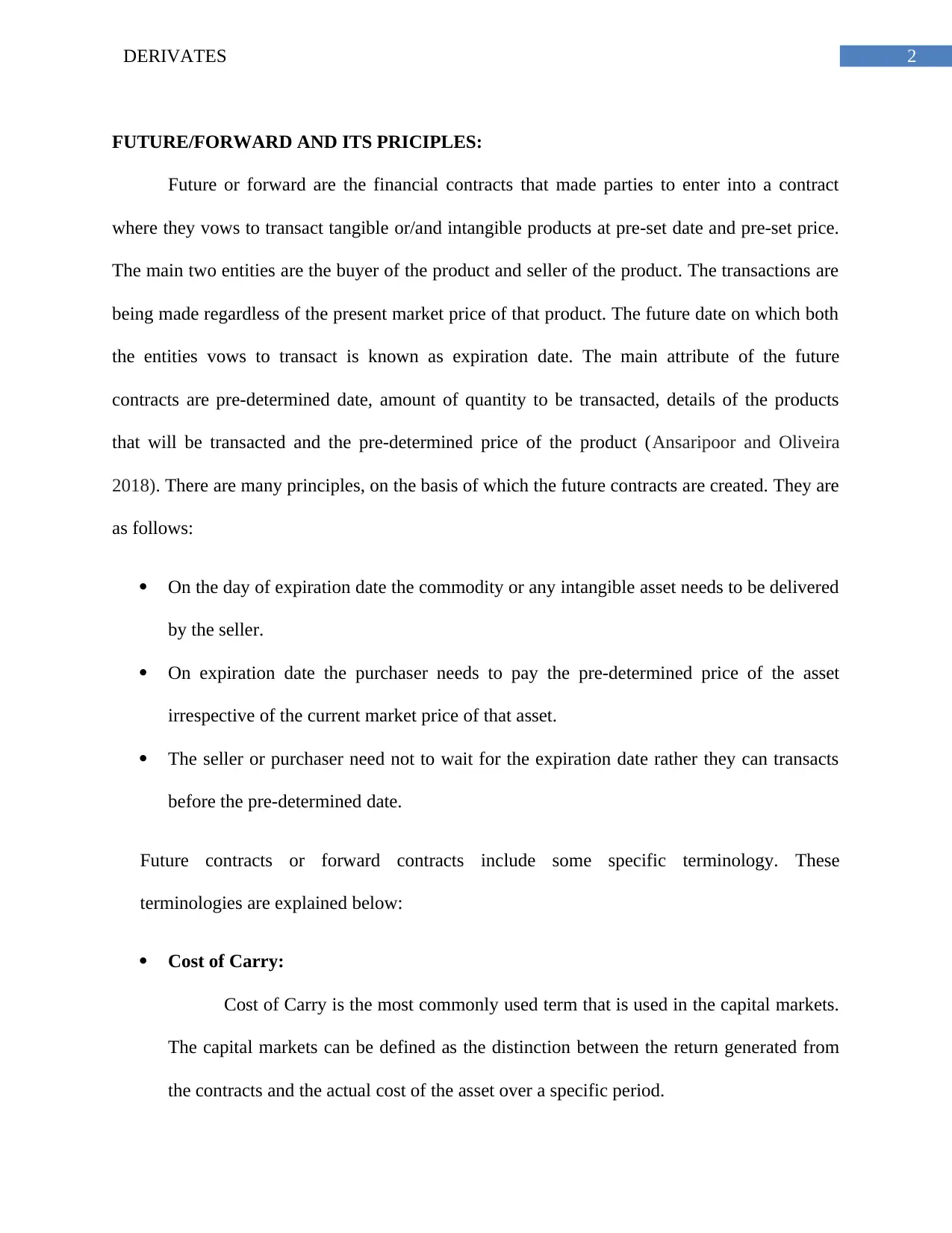
2DERIVATES
FUTURE/FORWARD AND ITS PRICIPLES:
Future or forward are the financial contracts that made parties to enter into a contract
where they vows to transact tangible or/and intangible products at pre-set date and pre-set price.
The main two entities are the buyer of the product and seller of the product. The transactions are
being made regardless of the present market price of that product. The future date on which both
the entities vows to transact is known as expiration date. The main attribute of the future
contracts are pre-determined date, amount of quantity to be transacted, details of the products
that will be transacted and the pre-determined price of the product (Ansaripoor and Oliveira
2018). There are many principles, on the basis of which the future contracts are created. They are
as follows:
On the day of expiration date the commodity or any intangible asset needs to be delivered
by the seller.
On expiration date the purchaser needs to pay the pre-determined price of the asset
irrespective of the current market price of that asset.
The seller or purchaser need not to wait for the expiration date rather they can transacts
before the pre-determined date.
Future contracts or forward contracts include some specific terminology. These
terminologies are explained below:
Cost of Carry:
Cost of Carry is the most commonly used term that is used in the capital markets.
The capital markets can be defined as the distinction between the return generated from
the contracts and the actual cost of the asset over a specific period.
FUTURE/FORWARD AND ITS PRICIPLES:
Future or forward are the financial contracts that made parties to enter into a contract
where they vows to transact tangible or/and intangible products at pre-set date and pre-set price.
The main two entities are the buyer of the product and seller of the product. The transactions are
being made regardless of the present market price of that product. The future date on which both
the entities vows to transact is known as expiration date. The main attribute of the future
contracts are pre-determined date, amount of quantity to be transacted, details of the products
that will be transacted and the pre-determined price of the product (Ansaripoor and Oliveira
2018). There are many principles, on the basis of which the future contracts are created. They are
as follows:
On the day of expiration date the commodity or any intangible asset needs to be delivered
by the seller.
On expiration date the purchaser needs to pay the pre-determined price of the asset
irrespective of the current market price of that asset.
The seller or purchaser need not to wait for the expiration date rather they can transacts
before the pre-determined date.
Future contracts or forward contracts include some specific terminology. These
terminologies are explained below:
Cost of Carry:
Cost of Carry is the most commonly used term that is used in the capital markets.
The capital markets can be defined as the distinction between the return generated from
the contracts and the actual cost of the asset over a specific period.
⊘ This is a preview!⊘
Do you want full access?
Subscribe today to unlock all pages.

Trusted by 1+ million students worldwide
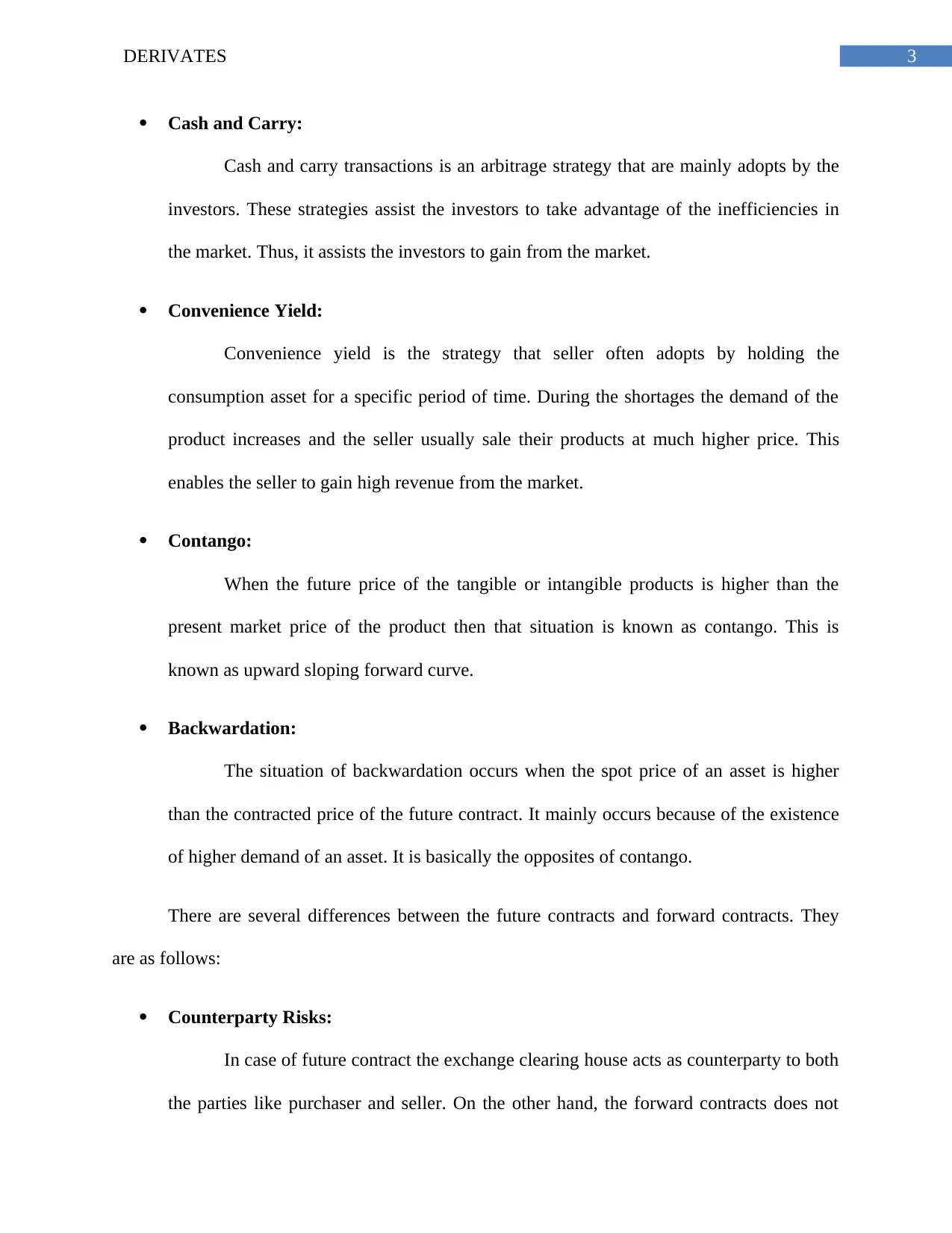
3DERIVATES
Cash and Carry:
Cash and carry transactions is an arbitrage strategy that are mainly adopts by the
investors. These strategies assist the investors to take advantage of the inefficiencies in
the market. Thus, it assists the investors to gain from the market.
Convenience Yield:
Convenience yield is the strategy that seller often adopts by holding the
consumption asset for a specific period of time. During the shortages the demand of the
product increases and the seller usually sale their products at much higher price. This
enables the seller to gain high revenue from the market.
Contango:
When the future price of the tangible or intangible products is higher than the
present market price of the product then that situation is known as contango. This is
known as upward sloping forward curve.
Backwardation:
The situation of backwardation occurs when the spot price of an asset is higher
than the contracted price of the future contract. It mainly occurs because of the existence
of higher demand of an asset. It is basically the opposites of contango.
There are several differences between the future contracts and forward contracts. They
are as follows:
Counterparty Risks:
In case of future contract the exchange clearing house acts as counterparty to both
the parties like purchaser and seller. On the other hand, the forward contracts does not
Cash and Carry:
Cash and carry transactions is an arbitrage strategy that are mainly adopts by the
investors. These strategies assist the investors to take advantage of the inefficiencies in
the market. Thus, it assists the investors to gain from the market.
Convenience Yield:
Convenience yield is the strategy that seller often adopts by holding the
consumption asset for a specific period of time. During the shortages the demand of the
product increases and the seller usually sale their products at much higher price. This
enables the seller to gain high revenue from the market.
Contango:
When the future price of the tangible or intangible products is higher than the
present market price of the product then that situation is known as contango. This is
known as upward sloping forward curve.
Backwardation:
The situation of backwardation occurs when the spot price of an asset is higher
than the contracted price of the future contract. It mainly occurs because of the existence
of higher demand of an asset. It is basically the opposites of contango.
There are several differences between the future contracts and forward contracts. They
are as follows:
Counterparty Risks:
In case of future contract the exchange clearing house acts as counterparty to both
the parties like purchaser and seller. On the other hand, the forward contracts does not
Paraphrase This Document
Need a fresh take? Get an instant paraphrase of this document with our AI Paraphraser
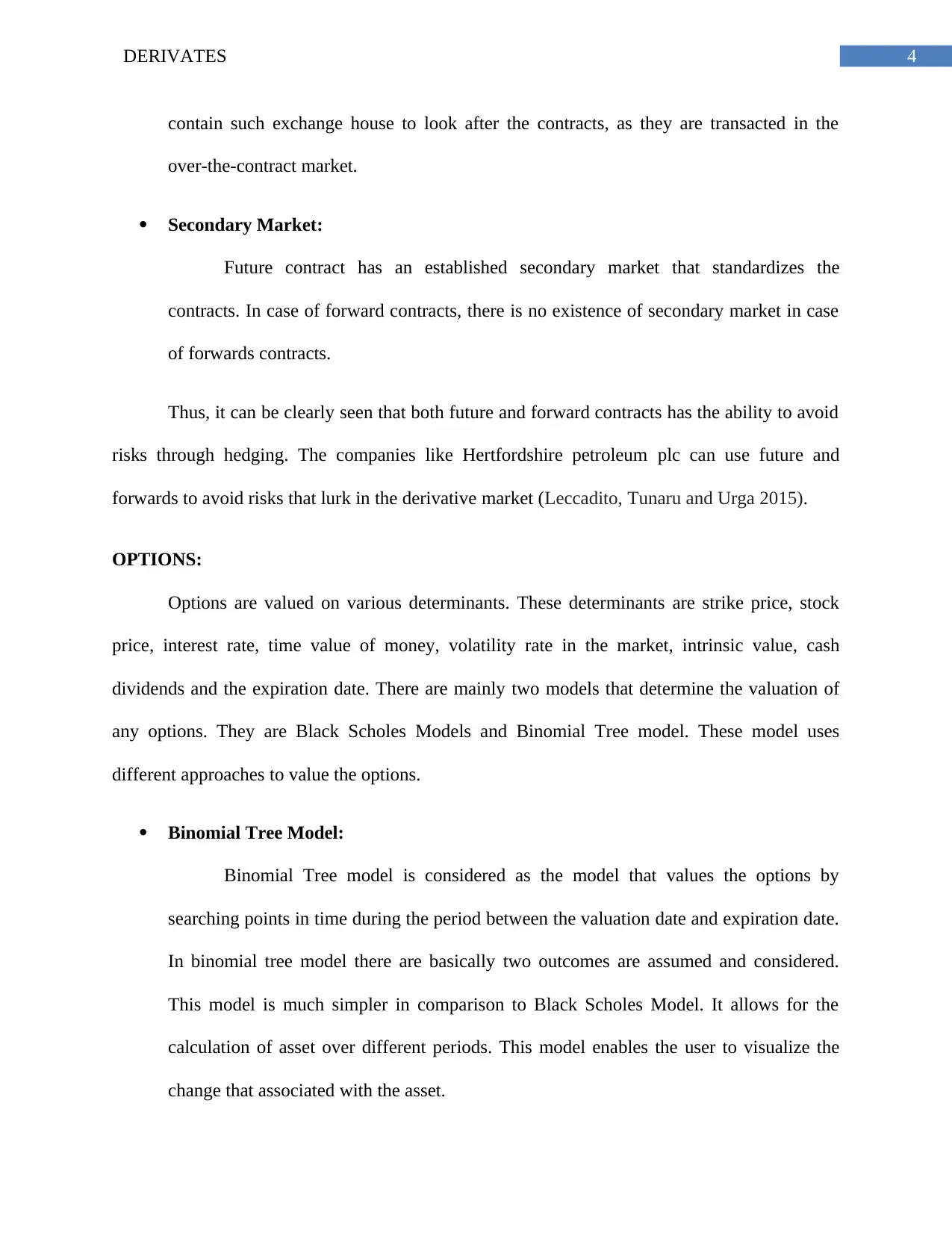
4DERIVATES
contain such exchange house to look after the contracts, as they are transacted in the
over-the-contract market.
Secondary Market:
Future contract has an established secondary market that standardizes the
contracts. In case of forward contracts, there is no existence of secondary market in case
of forwards contracts.
Thus, it can be clearly seen that both future and forward contracts has the ability to avoid
risks through hedging. The companies like Hertfordshire petroleum plc can use future and
forwards to avoid risks that lurk in the derivative market (Leccadito, Tunaru and Urga 2015).
OPTIONS:
Options are valued on various determinants. These determinants are strike price, stock
price, interest rate, time value of money, volatility rate in the market, intrinsic value, cash
dividends and the expiration date. There are mainly two models that determine the valuation of
any options. They are Black Scholes Models and Binomial Tree model. These model uses
different approaches to value the options.
Binomial Tree Model:
Binomial Tree model is considered as the model that values the options by
searching points in time during the period between the valuation date and expiration date.
In binomial tree model there are basically two outcomes are assumed and considered.
This model is much simpler in comparison to Black Scholes Model. It allows for the
calculation of asset over different periods. This model enables the user to visualize the
change that associated with the asset.
contain such exchange house to look after the contracts, as they are transacted in the
over-the-contract market.
Secondary Market:
Future contract has an established secondary market that standardizes the
contracts. In case of forward contracts, there is no existence of secondary market in case
of forwards contracts.
Thus, it can be clearly seen that both future and forward contracts has the ability to avoid
risks through hedging. The companies like Hertfordshire petroleum plc can use future and
forwards to avoid risks that lurk in the derivative market (Leccadito, Tunaru and Urga 2015).
OPTIONS:
Options are valued on various determinants. These determinants are strike price, stock
price, interest rate, time value of money, volatility rate in the market, intrinsic value, cash
dividends and the expiration date. There are mainly two models that determine the valuation of
any options. They are Black Scholes Models and Binomial Tree model. These model uses
different approaches to value the options.
Binomial Tree Model:
Binomial Tree model is considered as the model that values the options by
searching points in time during the period between the valuation date and expiration date.
In binomial tree model there are basically two outcomes are assumed and considered.
This model is much simpler in comparison to Black Scholes Model. It allows for the
calculation of asset over different periods. This model enables the user to visualize the
change that associated with the asset.
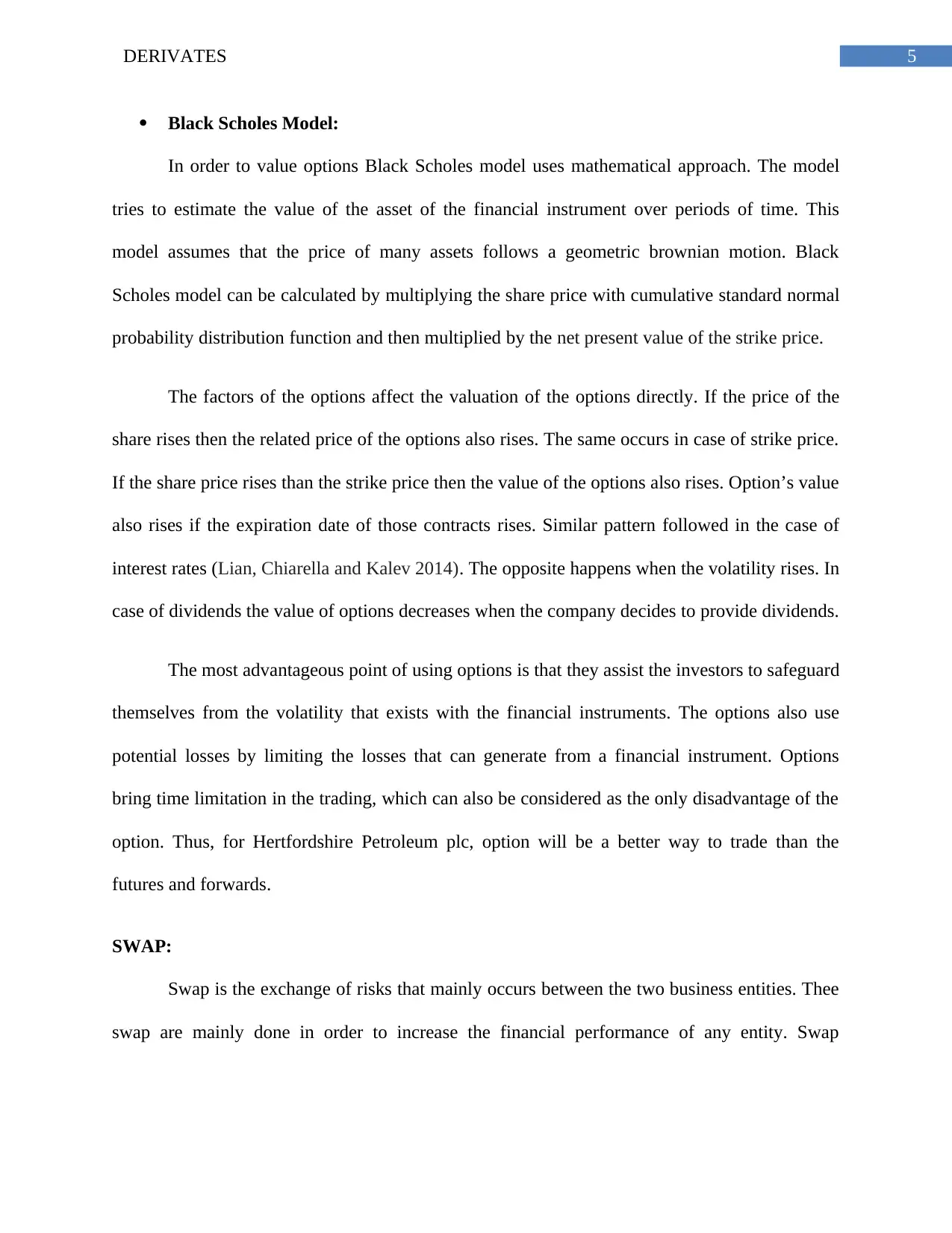
5DERIVATES
Black Scholes Model:
In order to value options Black Scholes model uses mathematical approach. The model
tries to estimate the value of the asset of the financial instrument over periods of time. This
model assumes that the price of many assets follows a geometric brownian motion. Black
Scholes model can be calculated by multiplying the share price with cumulative standard normal
probability distribution function and then multiplied by the net present value of the strike price.
The factors of the options affect the valuation of the options directly. If the price of the
share rises then the related price of the options also rises. The same occurs in case of strike price.
If the share price rises than the strike price then the value of the options also rises. Option’s value
also rises if the expiration date of those contracts rises. Similar pattern followed in the case of
interest rates (Lian, Chiarella and Kalev 2014). The opposite happens when the volatility rises. In
case of dividends the value of options decreases when the company decides to provide dividends.
The most advantageous point of using options is that they assist the investors to safeguard
themselves from the volatility that exists with the financial instruments. The options also use
potential losses by limiting the losses that can generate from a financial instrument. Options
bring time limitation in the trading, which can also be considered as the only disadvantage of the
option. Thus, for Hertfordshire Petroleum plc, option will be a better way to trade than the
futures and forwards.
SWAP:
Swap is the exchange of risks that mainly occurs between the two business entities. Thee
swap are mainly done in order to increase the financial performance of any entity. Swap
Black Scholes Model:
In order to value options Black Scholes model uses mathematical approach. The model
tries to estimate the value of the asset of the financial instrument over periods of time. This
model assumes that the price of many assets follows a geometric brownian motion. Black
Scholes model can be calculated by multiplying the share price with cumulative standard normal
probability distribution function and then multiplied by the net present value of the strike price.
The factors of the options affect the valuation of the options directly. If the price of the
share rises then the related price of the options also rises. The same occurs in case of strike price.
If the share price rises than the strike price then the value of the options also rises. Option’s value
also rises if the expiration date of those contracts rises. Similar pattern followed in the case of
interest rates (Lian, Chiarella and Kalev 2014). The opposite happens when the volatility rises. In
case of dividends the value of options decreases when the company decides to provide dividends.
The most advantageous point of using options is that they assist the investors to safeguard
themselves from the volatility that exists with the financial instruments. The options also use
potential losses by limiting the losses that can generate from a financial instrument. Options
bring time limitation in the trading, which can also be considered as the only disadvantage of the
option. Thus, for Hertfordshire Petroleum plc, option will be a better way to trade than the
futures and forwards.
SWAP:
Swap is the exchange of risks that mainly occurs between the two business entities. Thee
swap are mainly done in order to increase the financial performance of any entity. Swap
⊘ This is a preview!⊘
Do you want full access?
Subscribe today to unlock all pages.

Trusted by 1+ million students worldwide
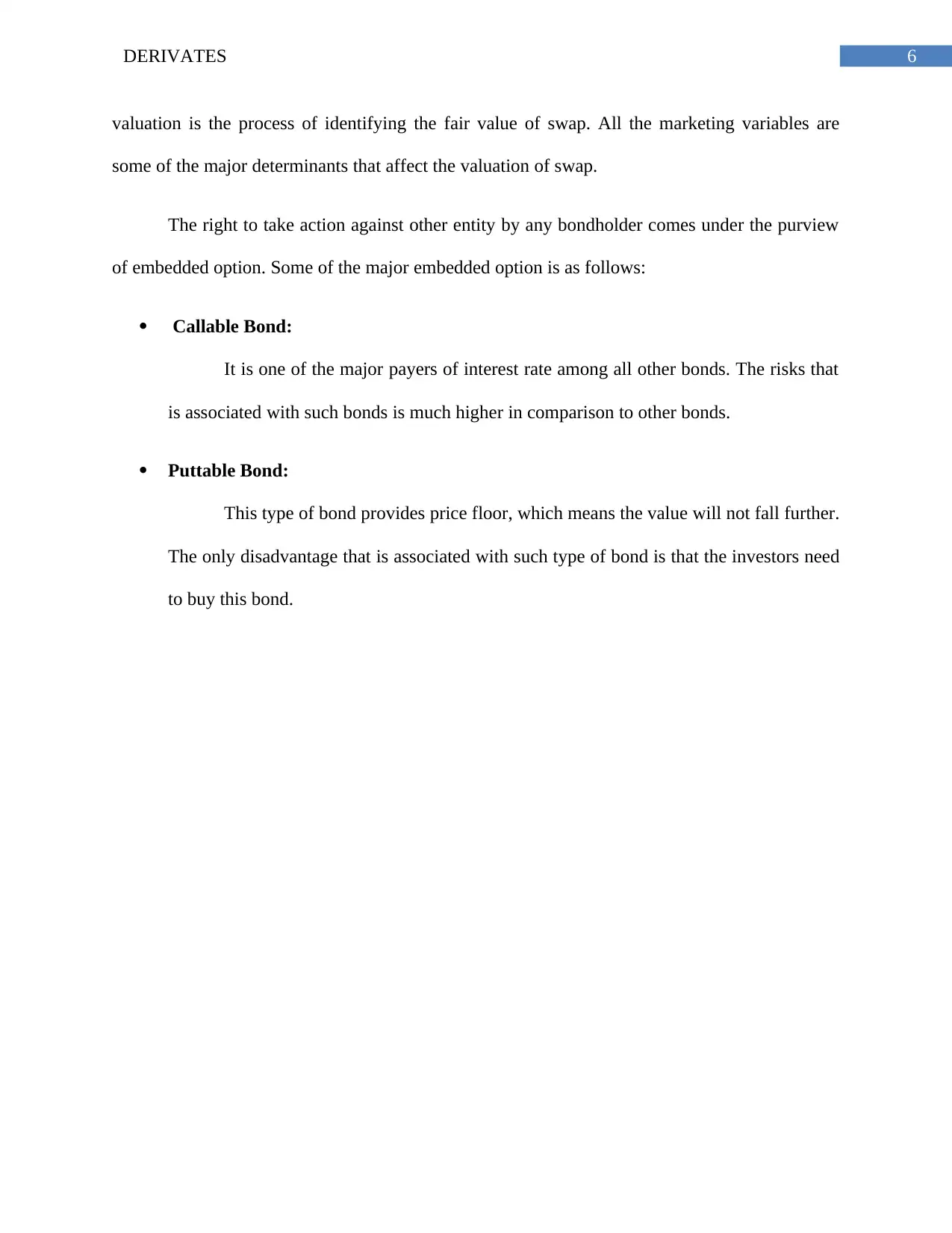
6DERIVATES
valuation is the process of identifying the fair value of swap. All the marketing variables are
some of the major determinants that affect the valuation of swap.
The right to take action against other entity by any bondholder comes under the purview
of embedded option. Some of the major embedded option is as follows:
Callable Bond:
It is one of the major payers of interest rate among all other bonds. The risks that
is associated with such bonds is much higher in comparison to other bonds.
Puttable Bond:
This type of bond provides price floor, which means the value will not fall further.
The only disadvantage that is associated with such type of bond is that the investors need
to buy this bond.
valuation is the process of identifying the fair value of swap. All the marketing variables are
some of the major determinants that affect the valuation of swap.
The right to take action against other entity by any bondholder comes under the purview
of embedded option. Some of the major embedded option is as follows:
Callable Bond:
It is one of the major payers of interest rate among all other bonds. The risks that
is associated with such bonds is much higher in comparison to other bonds.
Puttable Bond:
This type of bond provides price floor, which means the value will not fall further.
The only disadvantage that is associated with such type of bond is that the investors need
to buy this bond.
Paraphrase This Document
Need a fresh take? Get an instant paraphrase of this document with our AI Paraphraser
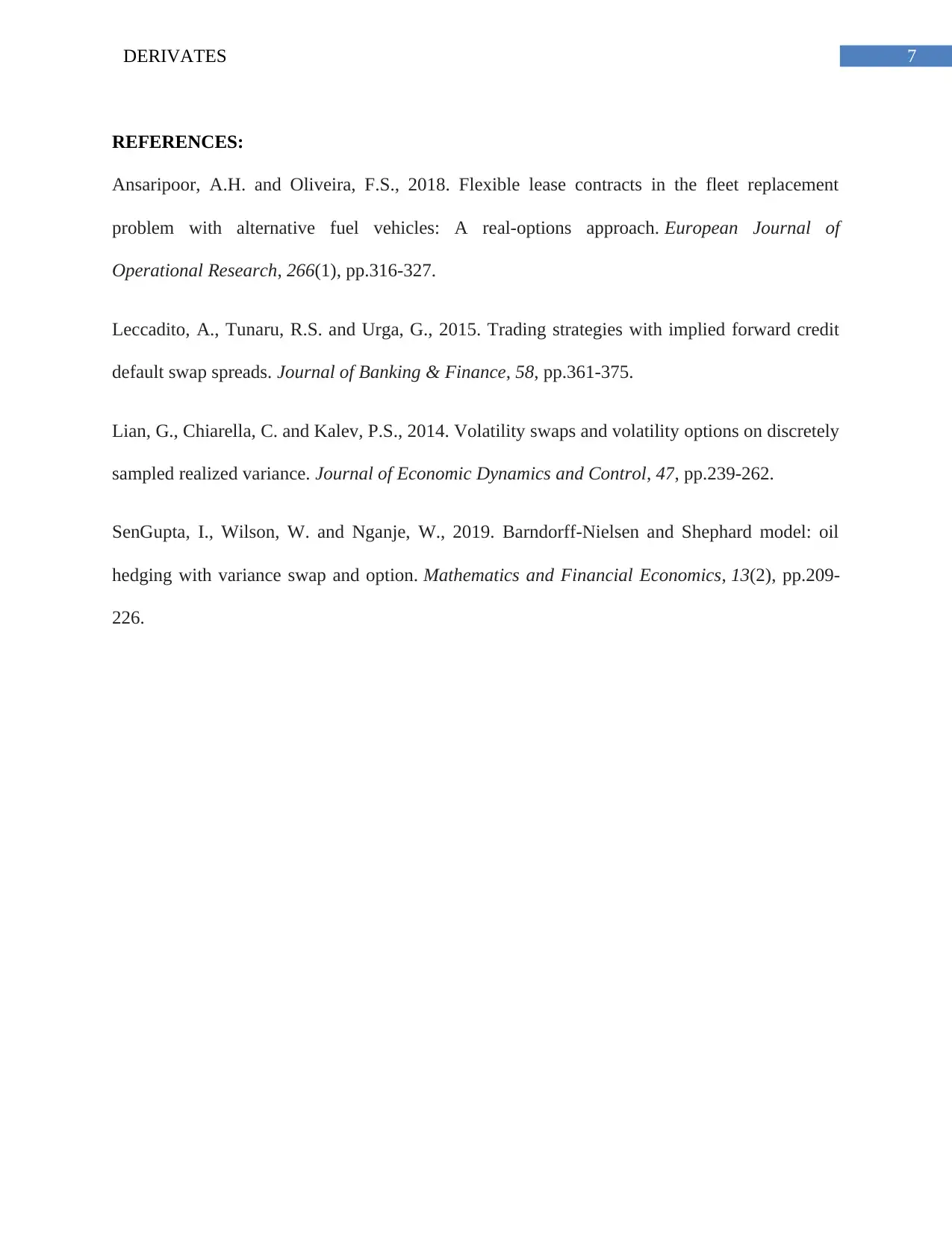
7DERIVATES
REFERENCES:
Ansaripoor, A.H. and Oliveira, F.S., 2018. Flexible lease contracts in the fleet replacement
problem with alternative fuel vehicles: A real-options approach. European Journal of
Operational Research, 266(1), pp.316-327.
Leccadito, A., Tunaru, R.S. and Urga, G., 2015. Trading strategies with implied forward credit
default swap spreads. Journal of Banking & Finance, 58, pp.361-375.
Lian, G., Chiarella, C. and Kalev, P.S., 2014. Volatility swaps and volatility options on discretely
sampled realized variance. Journal of Economic Dynamics and Control, 47, pp.239-262.
SenGupta, I., Wilson, W. and Nganje, W., 2019. Barndorff-Nielsen and Shephard model: oil
hedging with variance swap and option. Mathematics and Financial Economics, 13(2), pp.209-
226.
REFERENCES:
Ansaripoor, A.H. and Oliveira, F.S., 2018. Flexible lease contracts in the fleet replacement
problem with alternative fuel vehicles: A real-options approach. European Journal of
Operational Research, 266(1), pp.316-327.
Leccadito, A., Tunaru, R.S. and Urga, G., 2015. Trading strategies with implied forward credit
default swap spreads. Journal of Banking & Finance, 58, pp.361-375.
Lian, G., Chiarella, C. and Kalev, P.S., 2014. Volatility swaps and volatility options on discretely
sampled realized variance. Journal of Economic Dynamics and Control, 47, pp.239-262.
SenGupta, I., Wilson, W. and Nganje, W., 2019. Barndorff-Nielsen and Shephard model: oil
hedging with variance swap and option. Mathematics and Financial Economics, 13(2), pp.209-
226.
1 out of 8
Related Documents
Your All-in-One AI-Powered Toolkit for Academic Success.
+13062052269
info@desklib.com
Available 24*7 on WhatsApp / Email
![[object Object]](/_next/static/media/star-bottom.7253800d.svg)
Unlock your academic potential
Copyright © 2020–2025 A2Z Services. All Rights Reserved. Developed and managed by ZUCOL.





